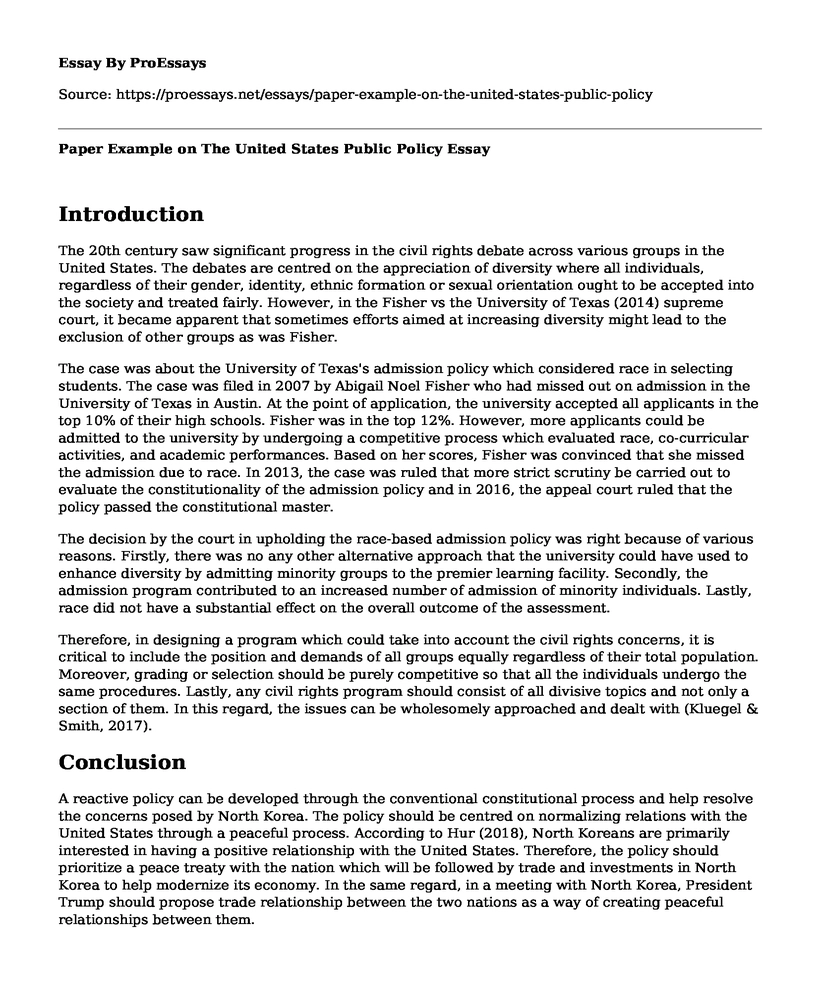Introduction
The 20th century saw significant progress in the civil rights debate across various groups in the United States. The debates are centred on the appreciation of diversity where all individuals, regardless of their gender, identity, ethnic formation or sexual orientation ought to be accepted into the society and treated fairly. However, in the Fisher vs the University of Texas (2014) supreme court, it became apparent that sometimes efforts aimed at increasing diversity might lead to the exclusion of other groups as was Fisher.
The case was about the University of Texas's admission policy which considered race in selecting students. The case was filed in 2007 by Abigail Noel Fisher who had missed out on admission in the University of Texas in Austin. At the point of application, the university accepted all applicants in the top 10% of their high schools. Fisher was in the top 12%. However, more applicants could be admitted to the university by undergoing a competitive process which evaluated race, co-curricular activities, and academic performances. Based on her scores, Fisher was convinced that she missed the admission due to race. In 2013, the case was ruled that more strict scrutiny be carried out to evaluate the constitutionality of the admission policy and in 2016, the appeal court ruled that the policy passed the constitutional master.
The decision by the court in upholding the race-based admission policy was right because of various reasons. Firstly, there was no any other alternative approach that the university could have used to enhance diversity by admitting minority groups to the premier learning facility. Secondly, the admission program contributed to an increased number of admission of minority individuals. Lastly, race did not have a substantial effect on the overall outcome of the assessment.
Therefore, in designing a program which could take into account the civil rights concerns, it is critical to include the position and demands of all groups equally regardless of their total population. Moreover, grading or selection should be purely competitive so that all the individuals undergo the same procedures. Lastly, any civil rights program should consist of all divisive topics and not only a section of them. In this regard, the issues can be wholesomely approached and dealt with (Kluegel & Smith, 2017).
Conclusion
A reactive policy can be developed through the conventional constitutional process and help resolve the concerns posed by North Korea. The policy should be centred on normalizing relations with the United States through a peaceful process. According to Hur (2018), North Koreans are primarily interested in having a positive relationship with the United States. Therefore, the policy should prioritize a peace treaty with the nation which will be followed by trade and investments in North Korea to help modernize its economy. In the same regard, in a meeting with North Korea, President Trump should propose trade relationship between the two nations as a way of creating peaceful relationships between them.
References
Hur, M. Y. (2018). North Korea's Second Nuclear Crisis and Inception of the SPT. In the Six-Party Talks on North Korea (pp. 21-82). Palgrave, Singapore.
Kluegel, J. R., & Smith, E. R. (2017). Beliefs about inequality: Americans' views of what is and what ought to be. London, L: Routledge.
Cite this page
Paper Example on The United States Public Policy. (2022, May 22). Retrieved from https://proessays.net/essays/paper-example-on-the-united-states-public-policy
If you are the original author of this essay and no longer wish to have it published on the ProEssays website, please click below to request its removal:
- Democracy Between 1865 and 1930s
- Chinese Entrepreneurship and Innovation Essay Example
- Essay Example on the Art of China: Ancient Traditions to Modern Era
- Essay on Cultural Heritage of China: Crucial for Nation's Development & Survival
- China's Export Boom: Manufacturing & Trade Hub - Essay Sample
- Africa's Economic Growth: Ethiopia, Rwanda, Ghana, Cote D'Ivoire Lead the Way - Essay Sample
- Govt Essential for Social Order: Its Role in Keeping Communities Civilised - Essay Sample







